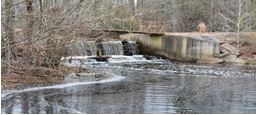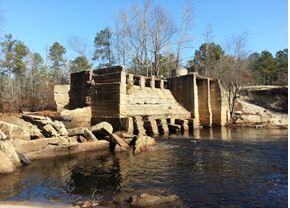DAM REMOVAL UPDATES
PROJECT UPDATE
2014/2015 Action Items
Over the past year, a sub-group of the Cape Fear River Partnership has been actively working to identify high priority barriers in the basin to remove or bypass to benefit anadromous fishes. This group is specifically working towards the completion of Action items:
Action 2.1: Pursue priority dam removal projects on the Little River, including an evaluation of the breached, unnamed dam on Fort Bragg property
Action 2.2: Apply prioritization tool for North Carolina to Cape Fear and barrier removal projects that will benefit migratory fish
Action 2.3: Continue discussions with owner of Lockville Dam about possible opportunities for future removal
Action 2.4: Pursue priority dam removal projects on the Haw and Deep Rivers
Action 3.2: Seek funding for removing priority obstructions or providing passage from analysis of Action 3.1
This group, made up of representatives from the USFWS, NOAA, American Rivers, Dial Cordy and Associates, Piedmont Conservation Council and SARP, has developed a methodology to identify and perform reconnaissance on potential fish passage projects using the North Carolina Barrier Prioritization tool.
Below are the steps developed to analyze potential fish passage projects:
Export Results from Barrier Prioritization Tool (BPT)
Together, the group has been running multiple iterations of the BPT on smaller subsets of the Cape Fear River basin. For instance, the tool has been run on the lower Cape Fear (below LD1) as well as the upper Cape Fear (above Buckhorn Dam) including dam removal targets within the Little, Haw, and Deep Rivers.
Explore dams on web map or GIS using local data sources and aerial photographs
The top priority dams are then explored in ArcGIS using aerial base maps, overlaying local data such as the herring habitat GIS analysis performed by Matt Hayes, anadromous fish spawning areas, and more.
Explore Several non-map Factors
If projects are deemed good possibilities given that the appropriate ecological metrics are met (few downstream dams, flow capable of supporting anadromous fishes, NCDOT crossings, etc.), then information about the dam’s owner, current use, and owner information is extracted from the data and the web.
Perform field visits
Field visits are then performed by experienced staff (i.e. Fritz Rohde, NOAA-NMFS) to assess the passability of the dam and identify if any natural barriers are present.
Land Owner Contact
Finally, the landowner is contacted by first attempting to find a shared contact. If none exists, other methods include sending a letter or cold calling.
WHAT COMES NEXT
2015 Goals and Targets
The process of connecting a top priority project with a willing landowner takes time. However, to this date the subgroup has conducted 6 site visits on potential dams and culverts for bypass. While not all of these sites were given the green light due to low flow or absence of a dam, all information collected informed the barrier database. The top priorities are:
Dodd’s Millpond Dam (Cape Fear River):
The subgroup has identified Dodd’s Millpond Dam, located below LD2 on Carver’s Creek, as a high priority to bypass for American eel and blueback herring. The landowner at this time is unwilling to remove the dam, as the impoundment is a Natural Heritage Area; however fish passage utilizing an Alaskan steeppass and eel passage is an option. This option will be explored further with the subgroup in 2015.

Photo by Fritz Rohde, NOAA-NMFS

Photo by Dawn York, Dial Cordy and Assoc.
Fort Bragg Unnamed Dam (Little River):
The abandoned dam on the Little River continues to surface to the top of the list for removal. Reaching an agreement with the environmental planning division of Fort Bragg is the next step action for the subgroup. A site visit was conducted in November 2012 by Dial Cordy and Associates and American Rivers. There are several upstream dams as well that may provide additional benefits from removal.
Next Steps
- Continue to identify top priority dams in the Cape Fear River basin (Upper and Lower)
- Collaborate with the Piedmont Conservation Council to identify shared priority projects
- Identify culverts that may be a barrier to herring in the lower Cape Fear River Basin
- Continue to refine the process of identifying high priority barriers
- Follow up on projects still “up in the air” to generate active restoration projects
- Develop funding proposals for high priority projects for upcoming funding opportunities (i.e. USFWS Fish Passage Program, Tronox restoration funds, etc.)





